American History II
Topic outline
-
Welcome to CHIS 2023: American History II.
Course Introduction
American History II is a survey of United States history from the Civil War era to the present. This course will survey American history from Reconstruction to the modern-day. Students are encouraged to think critically about events, people, and developments covered during the course of the semester. The course is designed to meet the general education goals listed in the catalog. Students will learn how to think critically, research, analyze documents, communicate effectively, and improve their information literacy, all skills that can be applied in a variety of careers.
Upon successful completion of this course, the student will be able to achieve the following Course Level Objectives (hereafter referred to as CO throughout the rest of the course):
-
Distinguish events and figures of American history since 1865 by time, place and action.
-
Explain basic arguments of ongoing historical debates by evaluating primary and secondary source material.
-
Explain the factors that shaped the development of America after the Reconstruction period.
-
Explain how the United States became a global superpower.
-
Analyze how the concept and legal definition of citizenship changed over time and the role of government in protecting the rights of citizens.
-
Compare and contrast the experience of different groups since Reconstruction, including marginalized groups.
-
Evaluate primary source documents of all types.
Adopting institution should provide learners information on how to navigate the course. Consider adding an introductory navigation video. Text description could include, for example:Navigating the Course
This course is set up in Modules covering various topics which may be accessed from the course navigation menu on the left or by scrolling below. Modules may be collapsed in the menu and it the body of the course to minimize scrolling. Each module includes the relevant chapters followed by various activities, which may include discussion forums, listening activities and quizzes, practice quizzes, module tests, and other relevant activities as appropriate for each module. Many items are required and may be marked as completed automatically when the activity has been submitted (the broken check box), but others will marked as done by the student (the solid check box).Please move through the items below and continue through the Learner Support and Getting Started modules before moving on to Module 1. Be sure to check for announcements and due dates to stay on track. This course and its contents are licensed under a Creative Commons Attribution 4.0 International License by LOUIS: The Louisiana Library Network, except where otherwise noted.
This course and its contents are licensed under a Creative Commons Attribution 4.0 International License by LOUIS: The Louisiana Library Network, except where otherwise noted. -
-
Chapter 1: The Era of Reconstruction, 1865–1877
-
This module contains all the items you should review and complete before you begin Module 1. Before moving on, be sure to:
- Check the News and Announcements Forum
- Read the Course Syllabus
- Introduce yourself to the class
- Read the instructions for the Q & A Forum
Good luck in the course!-
Use this forum to tell us a little about yourself and your interests. Some topic ideas:
- What is your field of study/research interest or concentration?
- What are you most interested in learning about in this class and why?
- Have you ever taken an online class before?
- Any other information you would like to share with your classmates, such as special interests or activities.
Post a picture! We look forward to meeting you.
-
Use this forum to ask your instructor any questions you have about the course. You may post at any time, and your instructor will respond here. Be as specific as possible.
Please keep in mind that others can see your posts, so do not post any personal information. If you have questions about your grade, please email your instructor directly. You can expect a response to posts and emails within 24 hours M-F, next business day on weekends.
- Check the News and Announcements Forum
-
Use the information in this module to customize the template to your needs. This module is currently hidden from students, and available for you to refer to throughout the semester.
-
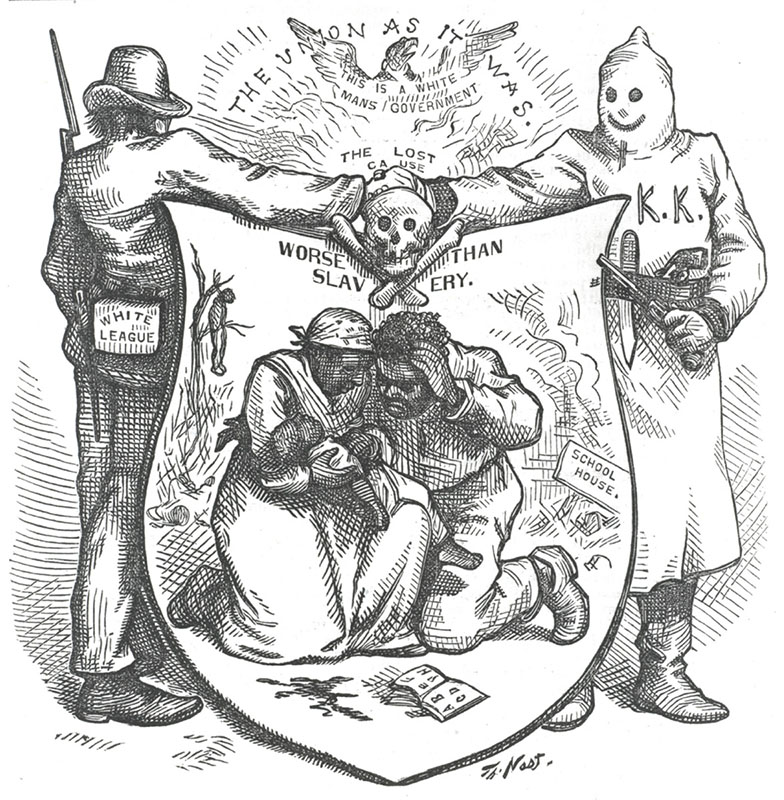
Image from Chapter 16 of U.S. History from OpenStax, licensed under Creative Commons Attribution License v4.0 with the image information: political cartoon by Thomas Nast, which appeared in Harper’s Weekly in October 1874.
Few times in U.S. history have been as turbulent and transformative as the Civil War and the twelve years that followed. Between 1865 and 1877, one president was murdered and another impeached. The Constitution underwent major revision with the addition of three amendments. This module will explore this turbulent time in depth.
In this module you will be presented with an overview of the Reconstruction Era, focusing on the following topics: presidential Reconstruction, the disparity between southern white and African American expectations for the post-war South, federal programs for Reconstruction, the successes and failures of Republican state governments in the South during Reconstruction, and the circumstances and decisions that brought an end to the Reconstruction era. Students will learn that although Reconstruction reunited the states after the Civil War, the Radical Republicans' idealist program of freedom and equality for Black Americans, was never fully supported by whites in either the North or the South, and many gains for African Americans collapsed by 1877. Although the Reconstruction amendments (13,14, and 15) remained on the books but were unenforced until a “second Reconstruction” in the Civil Rights movement in the 20th century.Upon completion of this module, you will be able to:- Describe Lincoln’s plan to restore the Union at the end of the Civil War (CO 1-5)
- Discuss the tenets of Radical Republicanism (CO 1-5)
- Analyze the success or failure of the Thirteenth Amendment (CO 1-5)
- Describe the efforts made by Congress in 1865 and 1866 to bring to life its vision of Reconstruction (CO 1-5)
- Explain how the Fourteenth Amendment transformed the Constitution (CO 1-5)
- Explain the purpose of the second phase of Reconstruction and some of the key legislation put forward by Congress (CO1-5)
- Describe the impeachment of President Johnson (CO 1-5)
- Discuss the benefits and drawbacks of the Fifteenth Amendment (CO 1-5)
- Explain the reasons for the collapse of Reconstruction (CO 1-7)
- Describe the efforts of White southern “redeemers” to roll back the gains of Reconstruction (CO 1-7)
To achieve these objectives:
- Read the Module 1 Introduction above.
- Read and view the materials in Chapter 1 (click below)
- View the Chapter 1 PowerPoint below.
- Complete Module 1 quizzes/assignments/discussion boards based on chapter/document reading.
Module Pressbooks Resources and Activities
You will find the following resources and activities in this module at the Pressbooks website. Click on the links below to access or complete each item.
- Describe Lincoln’s plan to restore the Union at the end of the Civil War (CO 1-5)
-
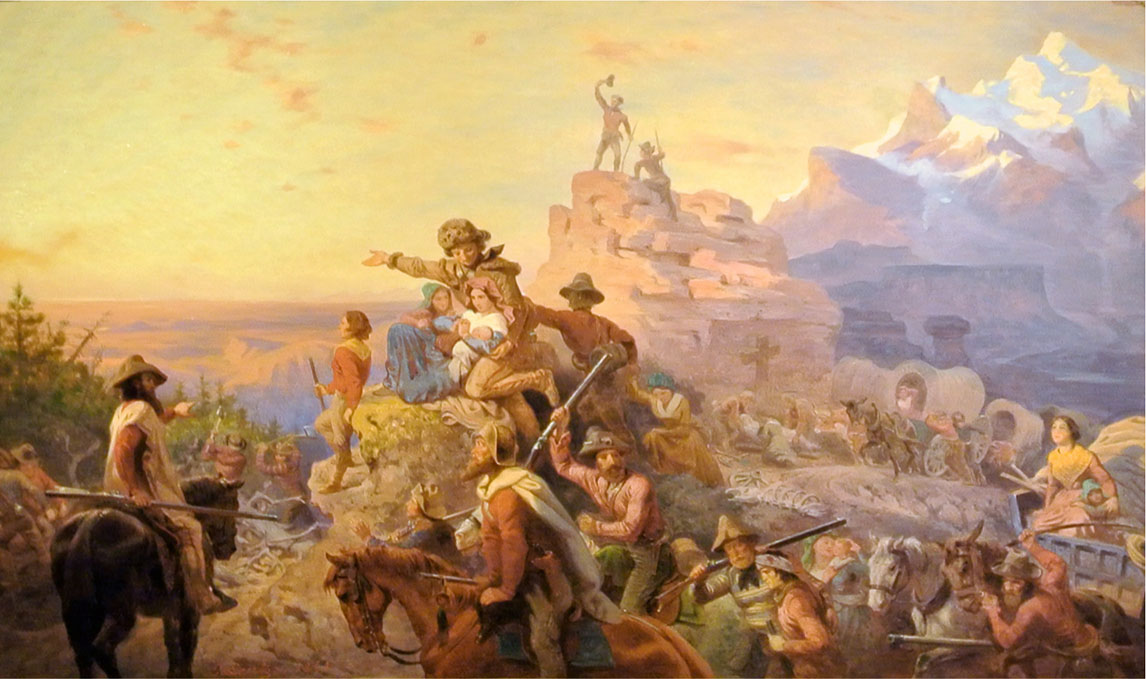 Image from Chapter 17 in U.S. History (opens in new window) from OpenStax, licensed under Creative Commons Attribution License v4.0 with the image information: A widely held belief in the nineteenth century contended that Americans had a divine right and responsibility to settle the West with Protestant democratic values. Newspaper editor Horace Greely, who coined the phrase “Go west, young man,” encouraged Americans to fulfill this dream. Artists of the day depicted this western expansion in idealized landscapes that bore little resemblance to the difficulties of life on the trail.
Image from Chapter 17 in U.S. History (opens in new window) from OpenStax, licensed under Creative Commons Attribution License v4.0 with the image information: A widely held belief in the nineteenth century contended that Americans had a divine right and responsibility to settle the West with Protestant democratic values. Newspaper editor Horace Greely, who coined the phrase “Go west, young man,” encouraged Americans to fulfill this dream. Artists of the day depicted this western expansion in idealized landscapes that bore little resemblance to the difficulties of life on the trail.
In the middle of the nineteenth century, farmers in the “Old West”—the land across the Allegheny Mountains in Pennsylvania—began to hear about the opportunities to be found in the “New West.” They had long believed that the land west of the Mississippi was a great desert, unfit for human habitation. But now, the federal government was encouraging them to join the migratory stream westward to this unknown land. For a variety of reasons, Americans increasingly felt compelled to fulfill their “Manifest Destiny,” a phrase that came to mean that they were expected to spread across the land given to them by God and, most importantly, spread predominantly American values to the frontier. This module explores Westward Expansion.
Upon completion of this module, you will be able to:- Explain the evolution of American views about westward migration in the mid-nineteenth century (CO 1-7)
- Analyze the ways in which the federal government facilitated Americans’ westward migration in the mid-nineteenth century (CO 1-5)
- Identify the challenges that farmers faced as they settled west of the Mississippi River (CO 1-7)
- Describe the unique experiences of women who participated in westward migration (CO 1-7)
- Identify the major discoveries and developments in western gold, silver, and copper mining in the mid-nineteenth century (CO 1-5)
- Explain why the cattle industry was paramount to the development of the West and how it became the catalyst for violent range wars (CO 1-5)
- Describe the methods that the U.S. government used to address the “Indian problem” during the settlement of the West (CO 1-7)
- Explain the United States policy of Americanization as it applied to Native peoples in the nineteenth century (CO 1-7)
- Describe the treatment of Chinese immigrants and Hispanic citizens during the westward expansion of the nineteenth century (CO 1-5)
To achieve these objectives:
- Read the Module 2 Introduction above.
- Read and view the materials in Module 2 (click below)
- View the Module 2 PowerPoint below.
- Complete Module 2 quizzes/assignments/discussion boards based on chapter/document reading.
Module Pressbooks Resources and Activities
You will find the following resources and activities in this module at the Pressbooks website. Click on the links below to access or complete each item.
- Explain the evolution of American views about westward migration in the mid-nineteenth century (CO 1-7)
-
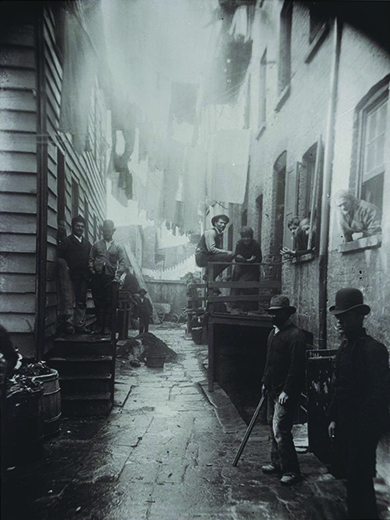
Image from Chapter 19 in U.S. History from OpenStax, licensed under Creative Commons Attribution License v4.0 with the image information: In photographs such as Bandit’s Roost (1888), taken on Mulberry Street in the infamous Five Points neighborhood of Manhattan’s Lower East Side, Jacob Riis documented the plight of New York City slums in the late nineteenth century.
In this module, you will learn about the inventions and industrialization that helped define American in the last decades of the nineteenth century. You will investigate the business inventions, particularly the communication technologies, electric power production, and steel production. You will examine the leading tycoons of the period, notably Andrew Carnegie, John Rockefeller, and J.P. Morgan, individuals who not only accumulated great wealth, but also revolutionized business management. You will also explore how the tycoons built their wealth on the backs of laborers, who suffered through long hours for low wages in often dangerous conditions. Finally, you will analyze the growth of organized labor, including organizations like the American Federation of Labor and Knights of Labor, in response to the exploitation of workers.
Upon completion of this module, you will be able to:
Industrialization, 1870-1900
- Explain how the ideas and products of late-nineteenth-century inventors contributed to the rise of big business (CO 1-5)
- Explain how the inventions of the late nineteenth century changed everyday American life (CO 1-5)
- Explain how the inventions of the late nineteenth century contributed directly to industrial growth in America (CO 1-5)
- Identify the contributions of Andrew Carnegie, John Rockefeller, and J. P. Morgan to the new industrial order emerging in the late nineteenth century (CO 1-5)
- Describe the visions, philosophies, and business methods of the leaders of the new industrial order (CO 1-7)
- Explain the qualities of industrial working-class life in the late nineteenth century (CO 1-5)
- Analyze both workers’ desire for labor unions and the reasons for unions’ inability to achieve their goals (CO 1-7)
- Describe the characteristics of the new consumer culture that emerged at the end of the nineteenth century (CO 1-7)
The Growing Pains of Urbanization, 1870-1900
- Explain the growth of American cities in the late nineteenth century (CO 1-5)
- Identify the key challenges that Americans faced due to urbanization, as well as some of the possible solutions to those challenges (CO 1-7)
- Identify the factors that prompted African American and European immigration to American cities in the late nineteenth century (CO 1-5)
- Explain the discrimination and anti-immigration legislation that immigrants faced in the late nineteenth century (CO 1-5)
- Identify how each class of Americans—working class, middle class, and upper class—responded to the challenges associated with urban life (CO 1-7)
- Explain the process of machine politics and how it brought relief to working-class Americans (CO 1-5)
- Explain how American writers, both fiction and nonfiction, helped Americans to better understand the changes they faced in the late nineteenth and early twentieth centuries (CO 1-5)
- Identify some of the influential women and African American writers of the era (CO 1-7)
To achieve these objectives:
- Read the Module 3 Introduction above.
- Read and view the materials in Module 3 (click below)
- View the Module 3 PowerPoints below.
- Complete Module 3 quizzes/assignments/discussion boards based on chapter/document reading.
Module Pressbooks Resources and Activities
You will find the following resources and activities in this module at the Pressbooks website. Click on the links below to access or complete each item.
-
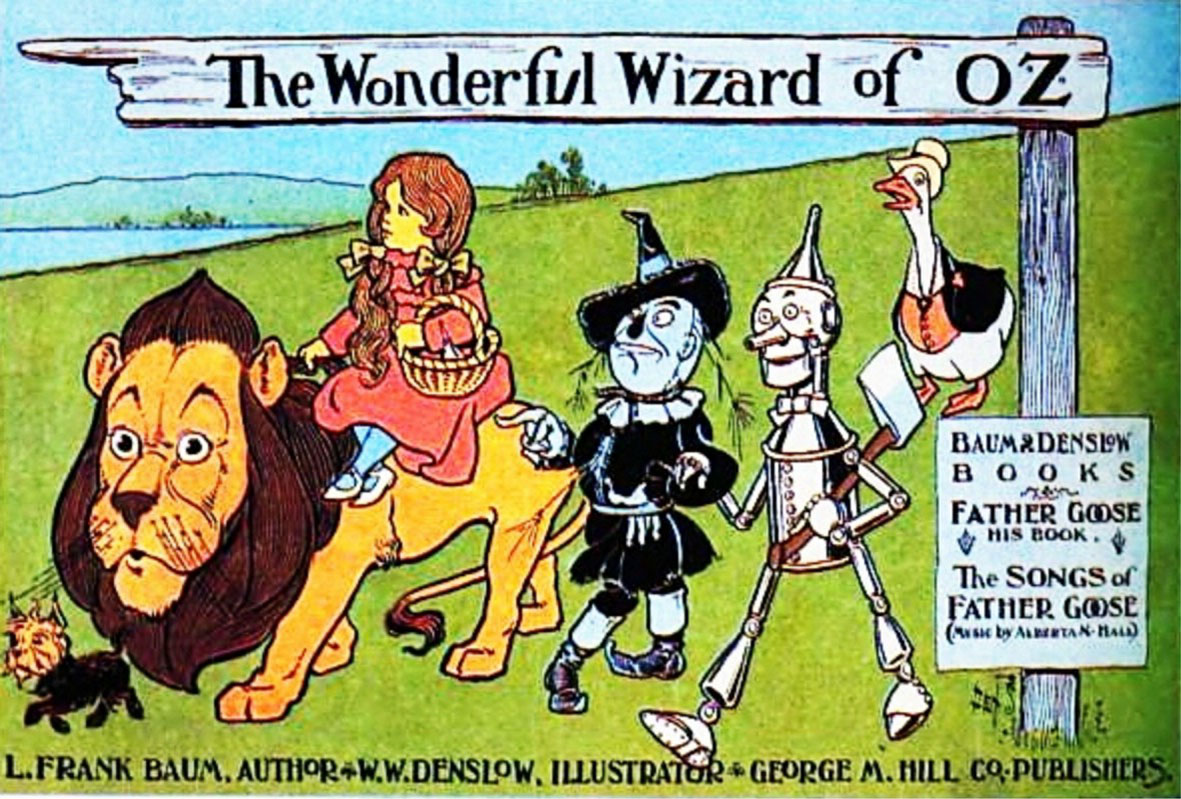 Image from Chapter 20 in U.S. History (opens in new window) from OpenStax, licensed under Creative Commons Attribution License v4.0 with the image information: L. Frank Baum's story of a Kansas girl and the magical land of Oz has become a classic of both film and screen, but it may have originated in part as an allegory of late nineteenth-century politics and the rise of the Populist movement.In this module, you will explore politics in the post-Civil War United States. In the years following the Civil War, American politics were disjointed, corrupt, and, at the federal level, largely ineffective in terms of addressing the challenges that Americans faced. All told, from 1872 through 1892, Gilded Age politics were little more than political showmanship. The political issues of the day, including the spoils system versus civil service reform, high tariffs versus low, and business regulation, all influenced politicians more than the country at large. Factors such as overproduction and high tariffs left the country’s farmers in increasingly desperate straits, and the federal government’s inability to address their concerns left them disillusioned and worried. As the economy worsened, more Americans suffered; as the federal government continued to offer few solutions, the Populist movement began to grow.Upon completion of this module, you will be able to:
Image from Chapter 20 in U.S. History (opens in new window) from OpenStax, licensed under Creative Commons Attribution License v4.0 with the image information: L. Frank Baum's story of a Kansas girl and the magical land of Oz has become a classic of both film and screen, but it may have originated in part as an allegory of late nineteenth-century politics and the rise of the Populist movement.In this module, you will explore politics in the post-Civil War United States. In the years following the Civil War, American politics were disjointed, corrupt, and, at the federal level, largely ineffective in terms of addressing the challenges that Americans faced. All told, from 1872 through 1892, Gilded Age politics were little more than political showmanship. The political issues of the day, including the spoils system versus civil service reform, high tariffs versus low, and business regulation, all influenced politicians more than the country at large. Factors such as overproduction and high tariffs left the country’s farmers in increasingly desperate straits, and the federal government’s inability to address their concerns left them disillusioned and worried. As the economy worsened, more Americans suffered; as the federal government continued to offer few solutions, the Populist movement began to grow.Upon completion of this module, you will be able to:- Discuss the national political scene during the Gilded Age (CO 1-5)
- Analyze why many critics considered the Gilded Age a period of ineffective national leadership (CO 1-7)
- Explain the difference between the spoils system and civil service, and discuss the importance of this issue in the period from 1872 to 1896 (CO 1-7)
- Recognize the ways in which the issue of tariffs impacted different sectors of the economy in late nineteenth-century America (CO 1-5)
- Explain why Americans were split on the issue of a national gold standard versus free coinage of silver (CO 1-7)
- Explain why political patronage was a key issue for political parties in the late nineteenth century CO 1-5)
- Understand how the economic and political climate of the day promoted the formation of the farmers’ protest movement in the latter half of the nineteenth century (CO 1-5)
- Explain how the farmers’ revolt moved from protest to politics (CO 1-5)
- Explain how the Depression of 1893 helped the Populist Party to grow in popularity in the 1890s (CO 1-5)
- Understand the forces that contributed to the Populist Party’s decline following the 1896 presidential election (CO 1-5)
To achieve these objectives:
- Read the Module 4 Introduction above.
- Read and view the materials in Module 4 (click below)
- View the Module 4 PowerPoint below.
- Complete Module 4 quizzes/assignments/discussion boards based on chapter/document reading.
Module Pressbooks Resources and Activities
You will find the following resources and activities in this module at the Pressbooks website. Click on the links below to access or complete each item.
-
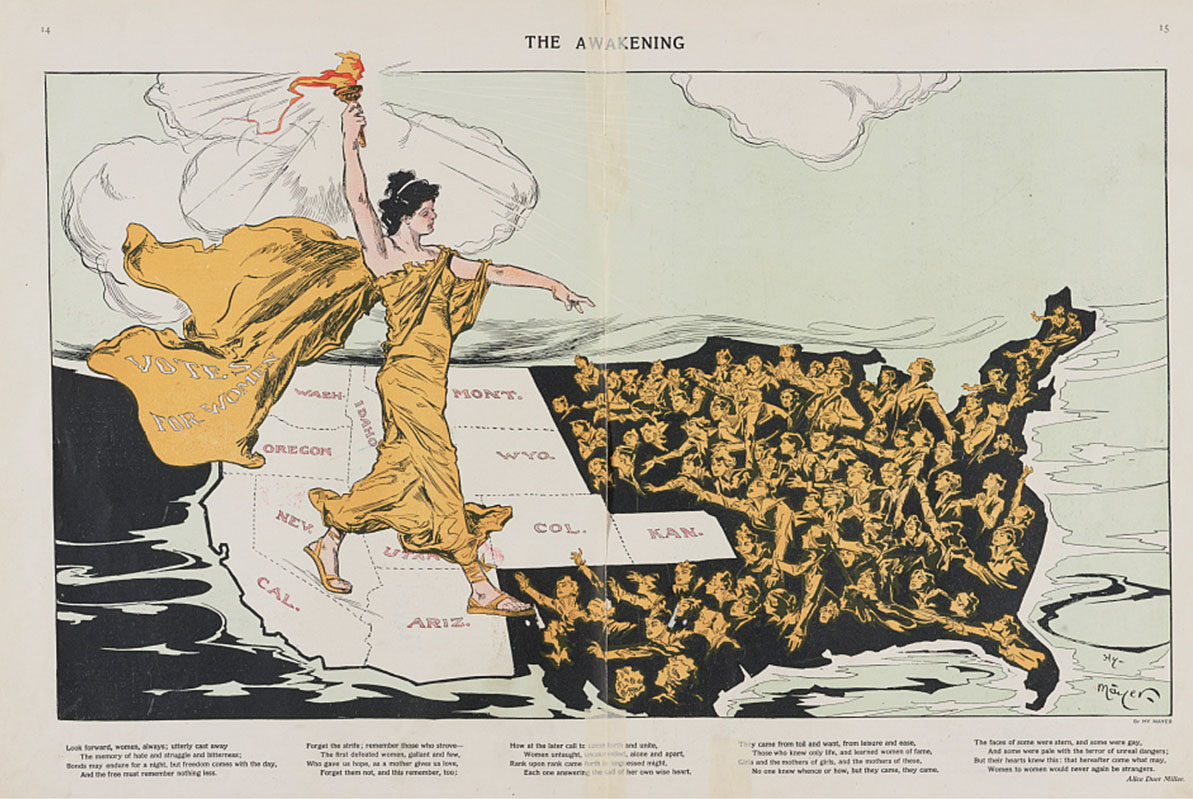 Image from Chapter 21 in U.S. History (opens in new window) from OpenStax, licensed under Creative Commons Attribution License v4.0 with the image information: The western states were the first to allow women the right to vote, a freedom that grew out of the less deeply entrenched gendered spheres in the region. This illustration, from 1915, shows a suffragist holding a torch over the western states and inviting the beckoning women from the rest of the country to join her.This module explores the Progressive Movement from 1890-1920. In its first decade, the Progressive Era was a grassroots effort that ushered in reforms at state and local levels. At the beginning of the twentieth century, however, Progressive endeavors captured the attention of the federal government. Progressive campaigns stretched from the hurricane-ruined townships of Texas to the slums of New York, from the factory floor to the saloon door. But what tied together these disparate causes and groups was the belief that the country was in dire need of reform. The Progressive commitment to promoting democracy and social justice created an environment within which the movements for women’s and African American rights grew and flourished. Theodore Roosevelt's activism in the executive branch spoke to the Progressive spirit in the nation and transformed the president’s office for the twentieth century.Upon completion of this module, you will be able to:
Image from Chapter 21 in U.S. History (opens in new window) from OpenStax, licensed under Creative Commons Attribution License v4.0 with the image information: The western states were the first to allow women the right to vote, a freedom that grew out of the less deeply entrenched gendered spheres in the region. This illustration, from 1915, shows a suffragist holding a torch over the western states and inviting the beckoning women from the rest of the country to join her.This module explores the Progressive Movement from 1890-1920. In its first decade, the Progressive Era was a grassroots effort that ushered in reforms at state and local levels. At the beginning of the twentieth century, however, Progressive endeavors captured the attention of the federal government. Progressive campaigns stretched from the hurricane-ruined townships of Texas to the slums of New York, from the factory floor to the saloon door. But what tied together these disparate causes and groups was the belief that the country was in dire need of reform. The Progressive commitment to promoting democracy and social justice created an environment within which the movements for women’s and African American rights grew and flourished. Theodore Roosevelt's activism in the executive branch spoke to the Progressive spirit in the nation and transformed the president’s office for the twentieth century.Upon completion of this module, you will be able to:- Describe the role that muckrakers played in catalyzing the Progressive Era (CO 1-7)
- Explain the main features of Progressivism (CO 1-5)
- Identify specific examples of grassroots Progressivism relating to the spread of democracy, efficiency in government, and social justice (CO 1-7)
- Describe the more radical movements associated with the Progressive Era (CO 1-5)
- Understand the origins and growth of the women’s rights movement (CO 1-7)
- Identify the different strands of the early African American civil rights movement (CO 1-5)
- Explain the key features of Theodore Roosevelt’s “Square Deal” (CO 1-5)
- Explain the key features of William Howard Taft’s Progressive agenda (CO 1-5)
- Identify the main pieces of legislation that Woodrow Wilson’s “New Freedom” agenda comprised (CO 1-7)
To achieve these objectives:
- Read the Module 5 Introduction above.
- Read and view the materials in Module 5 (click below)
- View the Module 5 PowerPoint below.
- Complete Module 5 quizzes/assignments/discussion boards based on chapter/document reading.
Module Pressbooks Resources and Activities
You will find the following resources and activities in this module at the Pressbooks website. Click on the links below to access or complete each item.
-
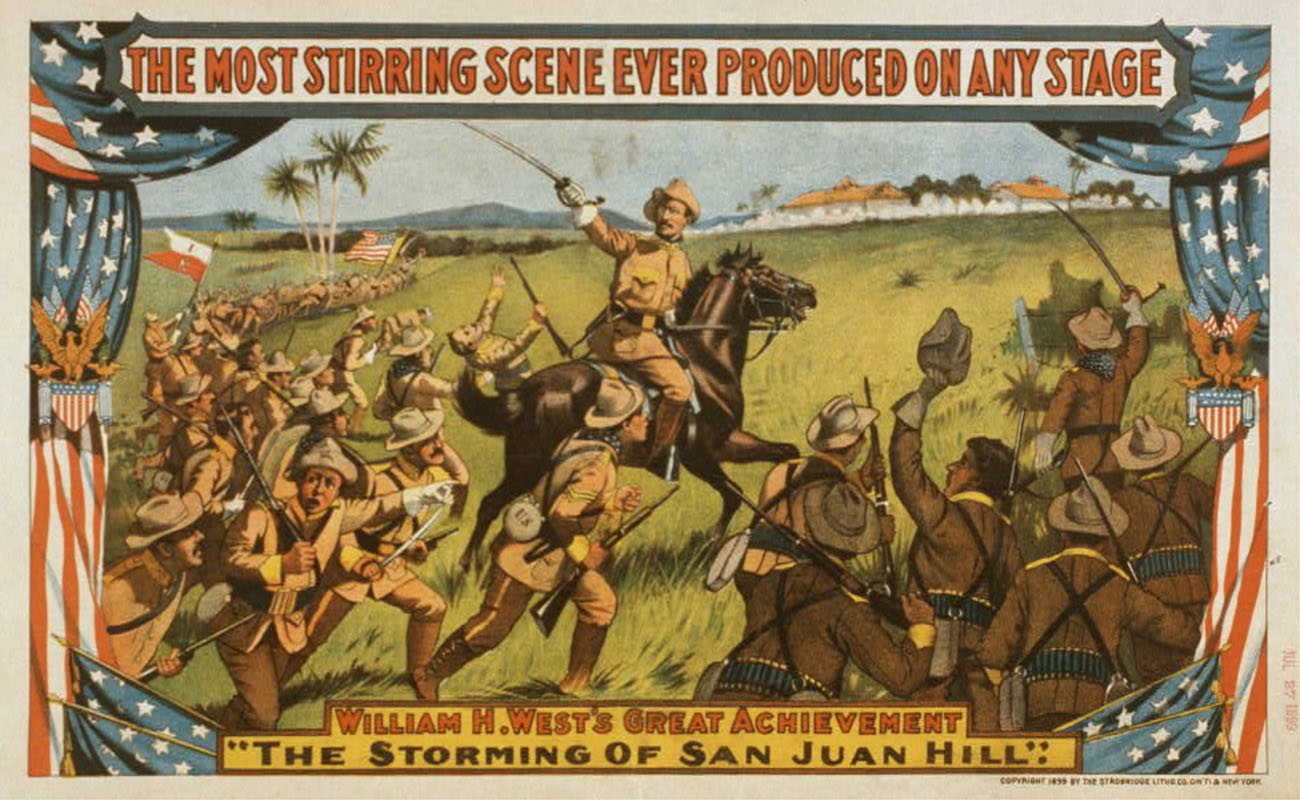 Image from Chapter 22 in U.S. History (opens in new window) from OpenStax, licensed under Creative Commons Attribution License v4.0 with the image information: This poster advertises a minstrel show wherein an actor playing Theodore Roosevelt reenacts his leadership of the Rough Riders in the Spanish-American War and illustrates the American public’s zeal for tales of American expansionist glory.This module explores the Age of Empire, an era of American expansionism. In the last decades of the nineteenth century, after the Civil War, the United States pivoted from a profoundly isolationist approach to a distinct zeal for American expansion. American economic growth combined with the efforts of Evangelist missionaries to push for greater international influence and overseas presence. By confronting Spain over its imperial rule in Cuba, the United States took control of valuable territories in Central America and the Pacific. But at the same time, the country sought to expand its reach through another powerful tool: its economic clout. When Roosevelt succeeded McKinley as president, he implemented a key strategy for building an American empire: the threat, rather than the outright use, of military force. All around the globe, President Taft sought to use U.S. economic might as a lever in foreign policy. He relied less on military action, or the threat of such action, than McKinley or Roosevelt before him.Upon completion of this module, you will be able to:
Image from Chapter 22 in U.S. History (opens in new window) from OpenStax, licensed under Creative Commons Attribution License v4.0 with the image information: This poster advertises a minstrel show wherein an actor playing Theodore Roosevelt reenacts his leadership of the Rough Riders in the Spanish-American War and illustrates the American public’s zeal for tales of American expansionist glory.This module explores the Age of Empire, an era of American expansionism. In the last decades of the nineteenth century, after the Civil War, the United States pivoted from a profoundly isolationist approach to a distinct zeal for American expansion. American economic growth combined with the efforts of Evangelist missionaries to push for greater international influence and overseas presence. By confronting Spain over its imperial rule in Cuba, the United States took control of valuable territories in Central America and the Pacific. But at the same time, the country sought to expand its reach through another powerful tool: its economic clout. When Roosevelt succeeded McKinley as president, he implemented a key strategy for building an American empire: the threat, rather than the outright use, of military force. All around the globe, President Taft sought to use U.S. economic might as a lever in foreign policy. He relied less on military action, or the threat of such action, than McKinley or Roosevelt before him.Upon completion of this module, you will be able to:- Explain the evolution of American interest in foreign affairs from the end of the Civil War through the early 1890s (CO 1-7)
- Identify the contributions of Frederick Jackson Turner and Alfred Thayer Mahan to the conscious creation of an American empire (CO 1-5)
- Explain the origins and events of the Spanish-American War (CO 1-7)
- Analyze the different American opinions on empire at the conclusion of the Spanish-American War (CO 1-5)
- Describe how the Spanish-American War intersected with other American expansions to solidify the nation’s new position as an empire (CO 1-5)
- Explain how economic power helped to expand America’s empire in China (CO 1-5)
- Describe how the foreign partitioning of China in the last decade of the nineteenth century influenced American policy (CO 1-5)
- Explain the meaning of “big stick” foreign policy (CO 1-7)
- Describe Theodore Roosevelt’s use of the “big stick” to construct the Panama Canal (CO 1-7)
- Explain the role of the United States in ending the Russo-Japanese War (CO 1-5)
- Explain how William Howard Taft used American economic power to protect the nation’s interests in its new empire (CO 1-5)
To achieve these objectives:
- Read the Module 6 Introduction above.
- Read and view the materials in Module 6 (click below)
- View the Module 6 PowerPoint below.
- Complete Module 6 quizzes/assignments/discussion boards based on chapter/document reading.
Module Pressbooks Resources and Activities
You will find the following resources and activities in this module at the Pressbooks website. Click on the links below to access or complete each item.
-
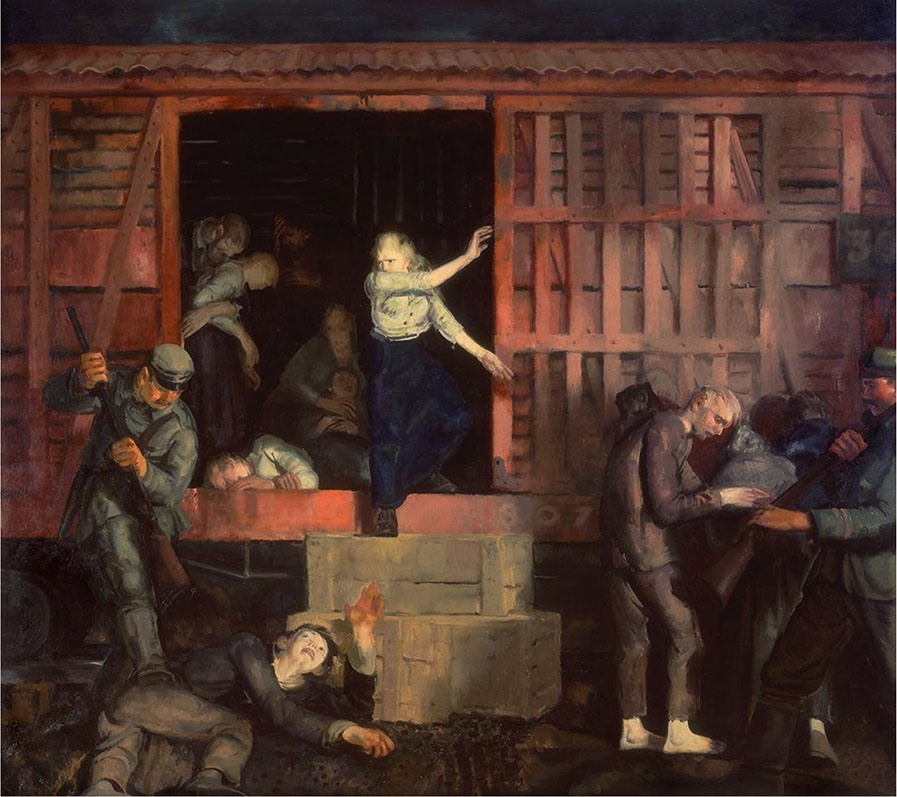 Image from Chapter 23 of U.S. History (opens in new window) from OpenStax, licensed under Creative Commons Attribution License v4.0 with the image information: Return of the Useless (1918), by George Bellows, is an example of a kind of artistic imagery used to galvanize reluctant Americans into joining World War I. The scene shows German soldiers unloading and mistreating imprisoned civilians after their return home to Belgium from German forced-labor camps.
Image from Chapter 23 of U.S. History (opens in new window) from OpenStax, licensed under Creative Commons Attribution License v4.0 with the image information: Return of the Useless (1918), by George Bellows, is an example of a kind of artistic imagery used to galvanize reluctant Americans into joining World War I. The scene shows German soldiers unloading and mistreating imprisoned civilians after their return home to Belgium from German forced-labor camps.This module explores America during World War I. You will examine how President Woodrow Wilson initially attempted to keep America out of the conflict between the European powers, and the events--including the sinking of U.S. ships by German u-boats and the infamous Zimmerman telegram--that shifted American opinion in favor of war. You will explore the government's efforts to prepare for war, including increased control over the economy, a propaganda campaign, and a military draft. You will also analyze the government's repressive measures, including the use of new laws to silence opposition to the war. You will investigate the changing American home front, including new opportunities for African Americans and women, particularly for the latter group with the passage of women's suffrage. You will examine the American contributions to the Allies' success, and the failure of President Wilson's Fourteen Points. Finally, you will analyze the difficult post-war period marked by the Influenza Pandemic of 1918-1919 and anti-Black riots.
Upon completion of this module, you will be able to:
- Explain Woodrow Wilson’s foreign policy and the difficulties of maintaining American neutrality at the outset of World War I (CO 1-7)
- Identify the key factors that led to the U.S. declaration of war on Germany in April 1917 (CO 1-5)
- Identify the steps taken by the U.S. government to secure enough men, money, food, and supplies to prosecute World War I (CO 1-5)
- Explain how the U.S. government attempted to sway popular opinion in favor of the war effort (CO 1-7)
- Explain how the status of organized labor changed during the First World War (CO 1-5)
- Describe how the lives of women and African Americans changed as a result of American participation in World War I (CO 1-5)
- Explain how America’s participation in World War I allowed for the passage of prohibition and women’s suffrage (CO 1-7)
- Identify the role that the United States played at the end of World War I (CO 1-5)
- Describe Woodrow Wilson’s vision for the postwar world (CO 1-7)
- Explain why the United States never formally approved the Treaty of Versailles nor joined the League of Nations (CO 1-5)
- Identify the challenges that the United States faced following the conclusion of World War I (CO 1-5)
- Explain Warren G. Harding’s landslide victory in the 1920 presidential election (CO 1-5)
To achieve these objectives:
- Read the Module 7 Introduction above.
- Read and view the materials in Module 7 (click below)
- View the Module 7 PowerPoint below.
- Complete Module 7 quizzes/assignments/discussion boards based on chapter/document reading.
-
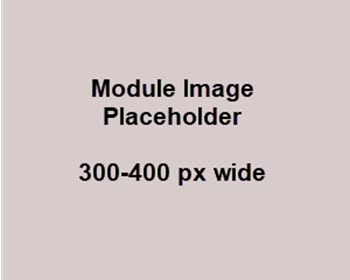
In this module you will take your midterm exam. Read the instructions carefully and take note of any special submission guidelines.
TO REVIEW TEAM: A Midterm Exam has not been uploaded at this point. One will be created over the summer if deemed necessary by the review team.
Upon completion of this module, you will have:
- Read and viewed the midterm exam instructions
- Scheduled your exam with the proctoring service (If necessary)
- Prepared for and submitted your midterm exam
To achieve these objectives:
- Read and view the contents of "Exam Information and Instructions"
- Log in to the proctoring service (if necessary) and take your exam.
-
 Image from Chapter 24 of U.S. History (opens in new window) from OpenStax, licensed under Creative Commons Attribution License v4.0 with the image information: The illustrations for F. Scott Fitzgerald’s Tales of the Jazz Age, drawn by John Held, Jr.
Image from Chapter 24 of U.S. History (opens in new window) from OpenStax, licensed under Creative Commons Attribution License v4.0 with the image information: The illustrations for F. Scott Fitzgerald’s Tales of the Jazz Age, drawn by John Held, Jr.This module explores the Jazz Age. Many middle-class Americans experienced prosperity in the 1920s. Old and the new came into sharp conflict. This divide was geographic and philosophical. Some people embraced the new amusements and social venues of the decade. Women found new opportunities for professional and political advancement, as well as new models of sexual liberation; however, the women’s rights movement began to wane. After World War I, Americans were ready for “a return to normalcy."
Upon completion of this module, you will be able to:
- Discuss the role of movies in the evolution of American culture (CO 1-7)
- Explain the impact of radio on nationalization and homogenization (CO 1-5)
- Analyze the ways in which the automobile, especially the Model T, transformed American life (CO 1-5)
- Define nativism and analyze the ways in which it affected the politics and society of the 1920s (CO 1-5)
- Describe the conflict between urban Americans and rural fundamentalists (CO 1-7)
- Explain the issues in question in the Scopes trial (CO 1-7)
- Explain the factors that shaped the new morality and the changing role of women in the United States during the 1920s (CO 1-5)
- Describe the “new Negro” and the influence of the Harlem Renaissance (CO 1-5)
- Analyze the effects of prohibition on American society and culture (CO 1-5)
- Describe the character and main authors of the Lost Generation (CO 1-7)
- Discuss Warren G. Harding’s strengths and weaknesses as president (CO 1-5)
- Explain how Calvin Coolidge was able to defeat the Democratic Party (CO 1-5)
- Explain what Calvin Coolidge meant by “the business of America is business” (CO 1-5)
To achieve these objectives:
- Read the Module 8 Introduction above.
- Read and view the materials in Module 8 (click below)
- View the Module 8 PowerPoint below.
- Complete Module 8 quizzes/assignments/discussion boards based on chapter/document reading.
Module Pressbooks Resources and Activities
You will find the following resources and activities in this module at the Pressbooks website. Click on the links below to access or complete each item.
-
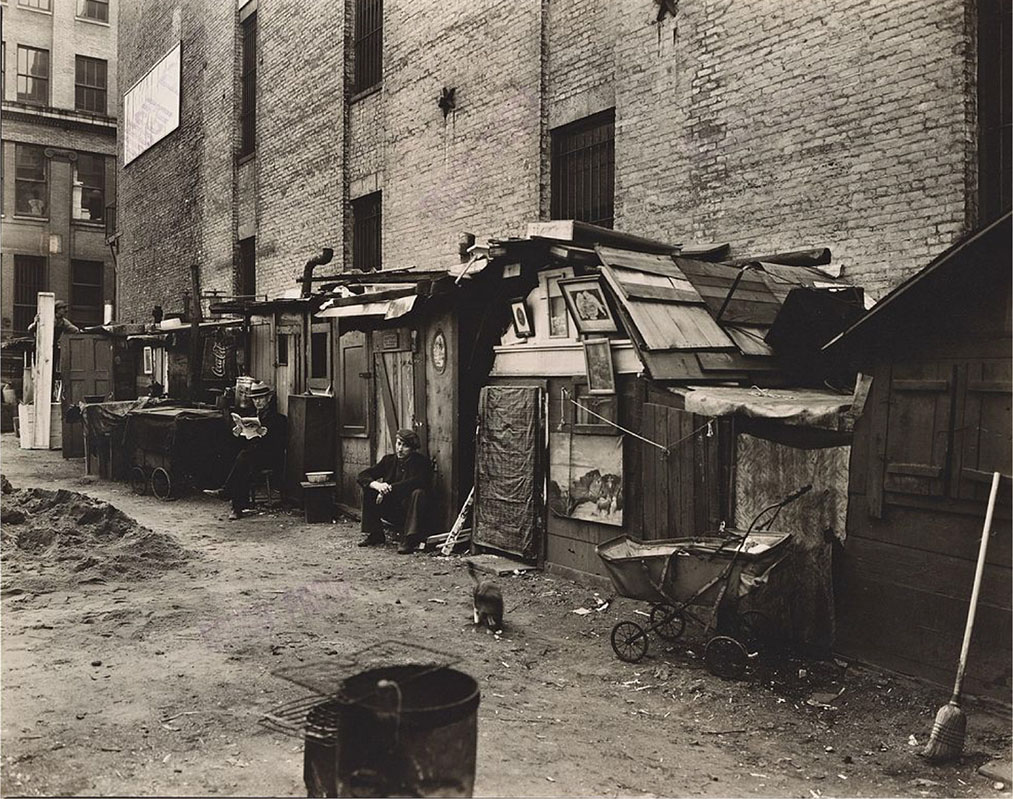 Image from Chapter 25 of U.S. History (opens in new window) from OpenStax, licensed under Creative Commons Attribution License v4.0 with the image information: In 1935, Berenice Abbott photographed these shanties in Lower Manhattan during the Great Depression. (credit: modification of work by Works Progress Administration)This module will explore the Great Depression. The prosperous decade of the 1920s led to the stock market crash of 1929. President Hoover’s deeply held philosophy of American individualism made him particularly unsuited to deal with the crisis of the Great Depression. The American public ultimately responded with anger and protest to Hoover’s apparent inability to create solutions. The Great Depression affected huge segments of the American population—sixty million people by one estimate. But certain groups, such as African Americans and Latinos, were hit harder than the rest. Hoover's record as a president will likely always bear the taint of his unwillingness to push through substantial government aid but, while his attitude toward civil rights mirrored his conviction that government intervention was a negative force, he did play a key role changing living conditions for Native Americans.Upon completion of this module, you will be able to:
Image from Chapter 25 of U.S. History (opens in new window) from OpenStax, licensed under Creative Commons Attribution License v4.0 with the image information: In 1935, Berenice Abbott photographed these shanties in Lower Manhattan during the Great Depression. (credit: modification of work by Works Progress Administration)This module will explore the Great Depression. The prosperous decade of the 1920s led to the stock market crash of 1929. President Hoover’s deeply held philosophy of American individualism made him particularly unsuited to deal with the crisis of the Great Depression. The American public ultimately responded with anger and protest to Hoover’s apparent inability to create solutions. The Great Depression affected huge segments of the American population—sixty million people by one estimate. But certain groups, such as African Americans and Latinos, were hit harder than the rest. Hoover's record as a president will likely always bear the taint of his unwillingness to push through substantial government aid but, while his attitude toward civil rights mirrored his conviction that government intervention was a negative force, he did play a key role changing living conditions for Native Americans.Upon completion of this module, you will be able to:- Identify the causes of the stock market crash of 1929 (CO 1-5)
- Assess the underlying weaknesses in the economy that resulted in America’s spiraling from prosperity to depression so quickly (CO 1-5)
- Compare how the stock market crash impacted different groups in America (CO 1-5)
- Explain Herbert Hoover’s responses to the Great Depression and how they reflected his political philosophy (CO 1-5)
- Describe the causes, objectives, and outcomes of Great Depression protests (CO 1-5)
- Analyze the frustration and anger that a majority of Americans directed at Herbert Hoover (CO 1-5)
- Identify the challenges that everyday Americans faced as a result of the Great Depression and analyze the government’s initial unwillingness to provide assistance (CO 1-7)
- Explain the particular challenges that African Americans faced during the crisis (CO 1-5)
- Identify the unique challenges that farmers in the Great Plains faced during this period (CO 1-7)
- Explain the Great Depression's influence on American values and popular culture (CO 1-7)
- Identify the successes and failures of Herbert Hoover’s presidency (CO 1-7)
- Determine the fairness and accuracy of assessments of Hoover’s presidency (CO 1-7)
To achieve these objectives:
- Read the Module 9 Introduction above.
- Read and view the materials in Module 9 (click below)
- View the Module 9 PowerPoint below.
- Complete Module 9 quizzes/assignments/discussion boards based on chapter/document reading.
Module Pressbooks Resources and Activities
You will find the following resources and activities in this module at the Pressbooks website. Click on the links below to access or complete each item.
-
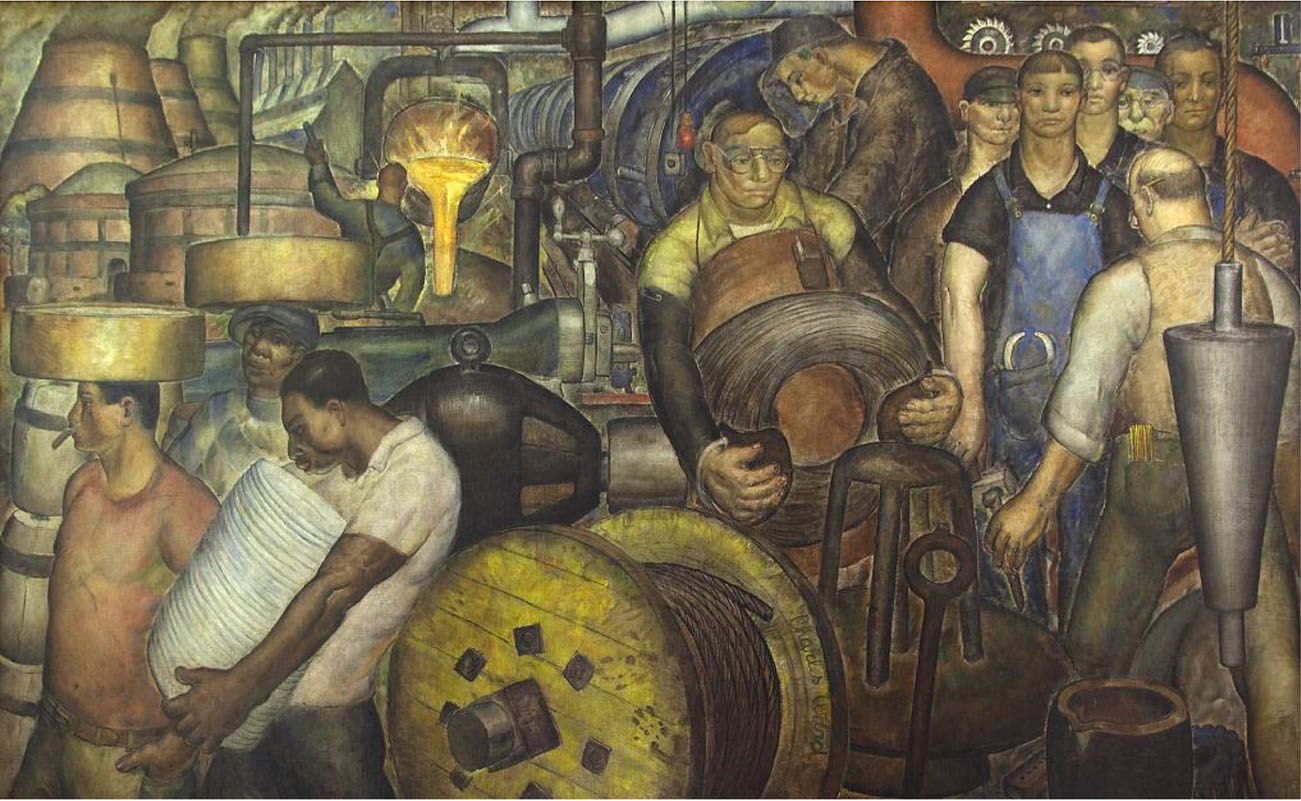 Image from Chapter 26 of U.S. History (opens in new window) from OpenStax, licensed under Creative Commons Attribution License v4.0 with the image information: President Roosevelt’s Federal Project Number One allowed thousands of artists to create public art. This initiative was a response to the Great Depression as part of the Works Project Administration, and much of the public art in cities today date from this era. New Deal by Charles Wells can be found in the Clarkson S. Fisher Federal Building and U.S. Courthouse in Trenton, New Jersey. (credit: modification of work by Library of Congress)This module explores Roosevelt and the New Deal. Franklin Delano Roosevelt and his attitude of optimism and possibility won the 1932 election in a landslide. Roosevelt lost no time in taking bold steps to fight back against the poverty and unemployment plaguing the country. Roosevelt had significant critics at the end of the First New Deal but the last major piece of New Deal legislation that Roosevelt passed was the Fair Labor Standards Act, which set a minimum wage, established a maximum-hour workweek, and forbade child labor. This law, as well as Social Security, still provides much of the social safety net in the United States today.Upon completion of this module, you will be able to:
Image from Chapter 26 of U.S. History (opens in new window) from OpenStax, licensed under Creative Commons Attribution License v4.0 with the image information: President Roosevelt’s Federal Project Number One allowed thousands of artists to create public art. This initiative was a response to the Great Depression as part of the Works Project Administration, and much of the public art in cities today date from this era. New Deal by Charles Wells can be found in the Clarkson S. Fisher Federal Building and U.S. Courthouse in Trenton, New Jersey. (credit: modification of work by Library of Congress)This module explores Roosevelt and the New Deal. Franklin Delano Roosevelt and his attitude of optimism and possibility won the 1932 election in a landslide. Roosevelt lost no time in taking bold steps to fight back against the poverty and unemployment plaguing the country. Roosevelt had significant critics at the end of the First New Deal but the last major piece of New Deal legislation that Roosevelt passed was the Fair Labor Standards Act, which set a minimum wage, established a maximum-hour workweek, and forbade child labor. This law, as well as Social Security, still provides much of the social safety net in the United States today.Upon completion of this module, you will be able to:- Describe the events of the 1932 presidential election and identify the characteristics that made Franklin Roosevelt a desirable candidate (CO 1-5)
- Explain why Congress amended the U.S. Constitution to reduce the period of time between presidential elections and inaugurations (CO 1-5)
- Identify the key pieces of legislation included in Roosevelt’s “First New Deal” (CO 1-5)
- Assess the strengths, weaknesses, and general effectiveness of the First New Deal (CO 1-7)
- Explain Roosevelt’s overall vision for addressing the structural problems in the U.S. economy (CO 1-5)
- Explain the ways that the Second New Deal addressed criticisms of the First New Deal (CO 1-5)
- Assess the entire New Deal, especially in terms of its impact on women, African Americans, and Native Americans (CO 1-7)
To achieve these objectives:
- Read the Module 10 Introduction above.
- Read and view the materials in Module 10 (click below)
- View the Module 10 PowerPoint below.
- Complete Module 10 quizzes/assignments/discussion boards based on chapter/document reading.
Module Pressbooks Resources and Activities
You will find the following resources and activities in this module at the Pressbooks website. Click on the links below to access or complete each item.
-
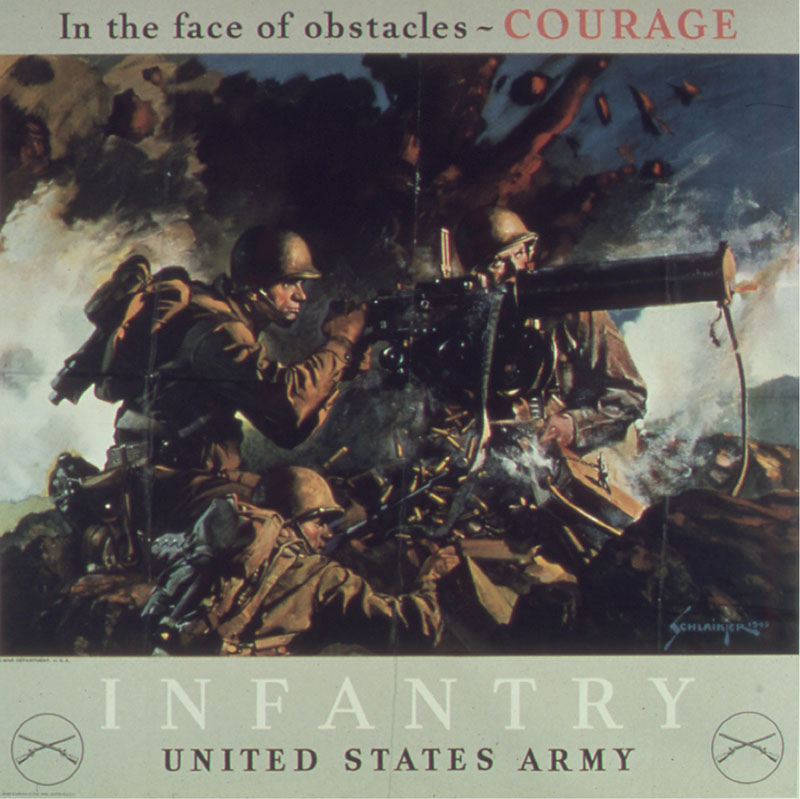 Image from Chapter 27 of U.S. History (opens in new window) from OpenStax, licensed under Creative Commons Attribution License v4.0 with the image information: During World War II, America propaganda was used to drum up patriotism and support for the war effort. This poster shows the grit and determination of infantrymen in the face of enemy fire.
Image from Chapter 27 of U.S. History (opens in new window) from OpenStax, licensed under Creative Commons Attribution License v4.0 with the image information: During World War II, America propaganda was used to drum up patriotism and support for the war effort. This poster shows the grit and determination of infantrymen in the face of enemy fire.
In this module, you will explore America during Word War II. After World War I, America sought to create new international relationships that would make such wars impossible in the future. But, as the Great Depression hit Europe, several new leaders rose to power under the new political ideologies of Fascism and Nazism. The brunt of the war’s damage occurred far from United States soil, but Women struggled to care for children with scarce resources at their disposal and sometimes while working full time. Strict rationing for the war effort meant that Americans still went without. Appeasement and nonintervention had been proven to be shortsighted and tragic. With the aid of the British, the United States invaded North Africa and from there invaded Europe by way of Italy but the cross-channel invasion through France did not come until 1944. The way in which the United States fought the war in the Pacific was fueled by fear of Japanese imperialistic aggression, as well as anger over Japan’s attack on Pearl Harbor and its mistreatment of its enemies.Upon completion of this module, you will be able to:- Explain the factors in Europe that gave rise to Fascism and Nazism (CO 1-5)
- Discuss the events in Europe and Asia that led to the start of the war (CO 1-5)
- Identify the early steps taken by President Franklin D. Roosevelt to increase American aid to nations fighting totalitarianism while maintaining neutrality (CO 1-5)
- Describe the steps taken by the United States to prepare for war (CO 1-5)
- Describe how the war changed employment patterns in the United States (CO 1-5)
- Discuss the contributions of civilians on the home front, especially women, to the war effort (CO 1-7)
- Analyze how the war affected race relations in the United States (CO 1-7)
- Identify the major battles of the European theater (CO 1-5)
- Analyze the goals and results of the major wartime summit meetings (CO 1-5)
- Discuss the strategy employed against the Japanese and some of the significant battles of the Pacific campaign (CO 1-5)
- Describe the effects of the atomic bombs on Hiroshima and Nagasaki (CO 1-5)
- Analyze the decision to drop atomic bombs on Japan (CO 1-7)
To achieve these objectives:
- Read the Module 11 Introduction above.
- Read and view the materials in Module 11 (click below)
- View the Module 11 PowerPoint below.
- Complete Module 11 quizzes/assignments/discussion boards based on chapter/document reading.
Module Pressbooks Resources and Activities
You will find the following resources and activities in this module at the Pressbooks website. Click on the links below to access or complete each item.
-
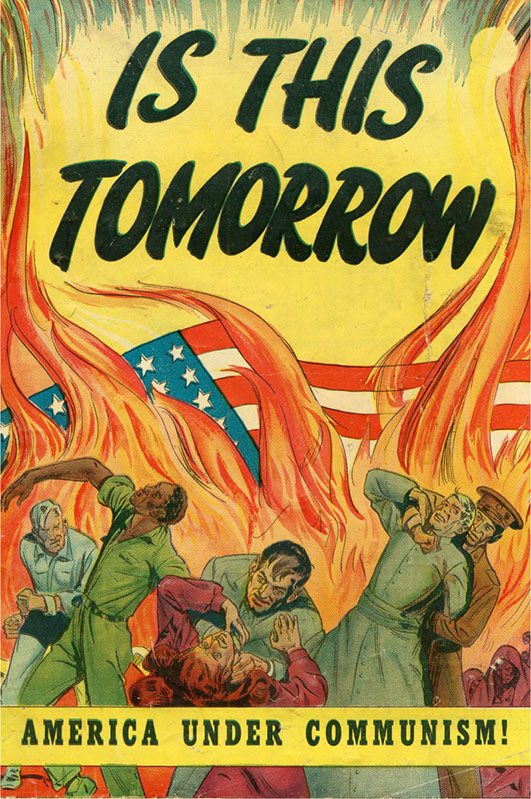 Image from Chapter 28 of U.S. History (opens in new window) from OpenStax, licensed under Creative Commons Attribution License v4.0 with the image information: Is This Tomorrow? warned Americans about the potential horrors of living under a Communist dictatorship. Postwar propaganda such as this comic book, the cover of which showed invading Russians attacking Americans and the U.S. flag in flames, served to drum up fear during the Cold War.This module explores the post World War II United States. At the end of World War II, U.S. servicemen and women returned and all hoped the prosperity of the war years would continue but marginalized groups did not share in this prosperity. Joy at the ending of World War II was replaced by fears of conflict with the Soviet Union. Young Americans married in record numbers, moved to the growing suburbs, and gave birth to the largest generation to date in U.S. history. Young Americans in the postwar period had more disposable income and enjoyed greater material comfort than their parents. This allowed them to devote more time and money to the consumption of popular culture. After World War II, African American efforts to secure greater civil rights increased across the United States.Upon completion of this module, you will be able to:
Image from Chapter 28 of U.S. History (opens in new window) from OpenStax, licensed under Creative Commons Attribution License v4.0 with the image information: Is This Tomorrow? warned Americans about the potential horrors of living under a Communist dictatorship. Postwar propaganda such as this comic book, the cover of which showed invading Russians attacking Americans and the U.S. flag in flames, served to drum up fear during the Cold War.This module explores the post World War II United States. At the end of World War II, U.S. servicemen and women returned and all hoped the prosperity of the war years would continue but marginalized groups did not share in this prosperity. Joy at the ending of World War II was replaced by fears of conflict with the Soviet Union. Young Americans married in record numbers, moved to the growing suburbs, and gave birth to the largest generation to date in U.S. history. Young Americans in the postwar period had more disposable income and enjoyed greater material comfort than their parents. This allowed them to devote more time and money to the consumption of popular culture. After World War II, African American efforts to secure greater civil rights increased across the United States.Upon completion of this module, you will be able to:- Identify the issues that the nation faced during demobilization (CO 1-3)
- Explain the goals and objectives of the Truman administration (CO 1-3)
- Evaluate the actions taken by the U.S. government to address the concerns of returning veterans (CO 1-3)
- Explain how and why the Cold War emerged in the wake of World War II (CO 1-4)
- Describe the steps taken by the U.S. government to oppose Communist expansion in Europe and Asia (CO 1-4)
- Discuss the government’s efforts to root out Communist influences in the United States (CO 1-3)
- Describe President Dwight D. Eisenhower’s domestic and foreign policies (CO 1-3)
- Discuss gender roles in the 1950s (CO 1-3)
- Discuss the growth of the suburbs and the effect of suburbanization on American society (CO 1-3)
- Describe Americans’ different responses to rock and roll music (CO 1-3)
- Discuss the way contemporary movies and television reflected postwar American society (CO 1-3)
- Explain how Presidents Truman and Eisenhower addressed civil rights issues (CO 1-4)
- Discuss efforts by African Americans to end discrimination and segregation (CO 1-4)
- Describe southern White peoples’ response to the civil rights movement (CO 1-3)
To achieve these objectives:
- Read the Module 12 Introduction above.
- Read and view the materials in Module 12 (click below)
- View the Module 12 PowerPoint below.
- Complete Module 12 quizzes/assignments/discussion boards based on chapter/document reading.
Module Pressbooks Resources and Activities
You will find the following resources and activities in this module at the Pressbooks website. Click on the links below to access or complete each item.
-
In this module, you will explore the 1960s in the United States. Though most likely did not realize it, In the 1960s, Americans lived in the most economically prosperous decade, in the most economically prosperous country in all of human history. In the atmosphere of such a flourishing time, the country's new and dynamic President, John F. Kennedy, nonetheless challenged his fellow Americans to "...ask what you can do for your country," and admonished his fellow citizens to do their part to meet the social, political, and foreign policy challenges that still abounded around the nation.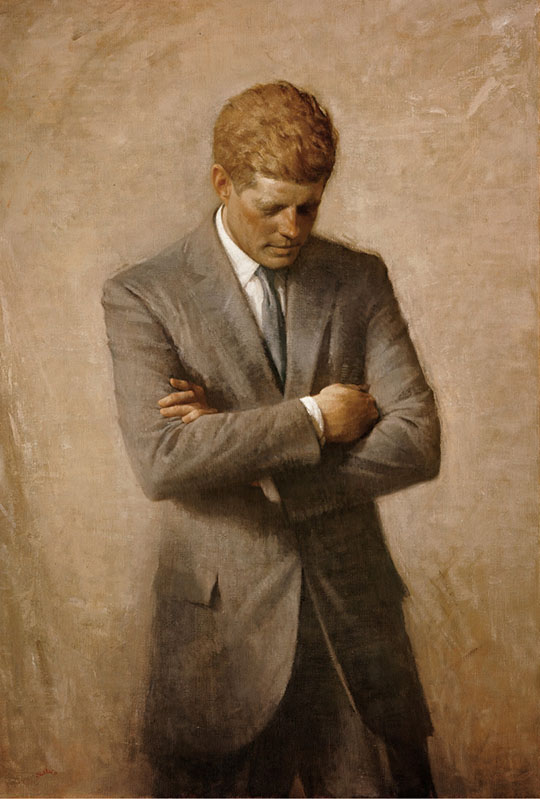 Image from Chapter 29 of U.S. History (opens in new window) from OpenStax, licensed under Creative Commons Attribution License v4.0 with the image information: In Aaron Shikler’s official portrait of John Fitzgerald Kennedy (1970), the president stands with arms folded, apparently deep in thought. The portrait was painted seven years after Kennedy’s death, at the request of his widow, Jacqueline Kennedy Onassis. It depicts the president with his head down, because Shikler did not wish to paint the dead man’s eyes.
Image from Chapter 29 of U.S. History (opens in new window) from OpenStax, licensed under Creative Commons Attribution License v4.0 with the image information: In Aaron Shikler’s official portrait of John Fitzgerald Kennedy (1970), the president stands with arms folded, apparently deep in thought. The portrait was painted seven years after Kennedy’s death, at the request of his widow, Jacqueline Kennedy Onassis. It depicts the president with his head down, because Shikler did not wish to paint the dead man’s eyes.
In 1960, though removed from slavery for nearly a century, African-Americans still did not enjoy the same levels of high post-war living standards that white Americans did, nor were voting rights widely available in much of the country. Despite Brown v. Board and other desegregation efforts of the 1950s, Jim Crow still prevailed across the South. Around the world, the Cold War with the Soviet Union intensified, the nuclear threat persisted, and (nearly) ignited over Cuba. In Asia, the U.S. was soon to be more and more involved in the "Big Muddy" quagmire of Vietnam. But the 1960s still began on a note of optimism, energy, and idealism. For a time JFK was the charismatic face of good times and visionary ideas, but by 1963, JFK fell victim to an assassin's bullet, and the 1960s were soon to take a much more challenging turn.
Upon completion of this module, you will be able to:
- Assess Kennedy’s Cold War strategy (CO 1-5)
- Describe Kennedy’s contribution to the civil rights movement (CO 1-5)
- Describe the major accomplishments of Lyndon Johnson’s Great Society (CO 1-5)
- Identify the legal advances made in the area of civil rights (CO 1-5)
- Explain how Lyndon Johnson deepened the American commitment in Vietnam (CO 1-5)
- Explain the strategies of the African American civil rights movement in the 1960s (CO 1-7)
- Discuss the rise and philosophy of Black Power (CO 1-7)
- Identify achievements of the Mexican American civil rights movement in the 1960s (CO 1-5)
- Describe the goals and activities of SDS, the Free Speech Movement, and the antiwar movement (CO 1-7)
- Explain the rise, goals, and activities of the women’s movement (CO 1-5)
To achieve these objectives:
- Read the Module 13 Introduction above.
- Read and view the materials in Module 13 (click below)
- View the Module 13 PowerPoint below.
- Complete Module 13 quizzes/assignments/discussion boards based on chapter/document reading.
Module Pressbooks Resources and Activities
You will find the following resources and activities in this module at the Pressbooks website. Click on the links below to access or complete each item.
-
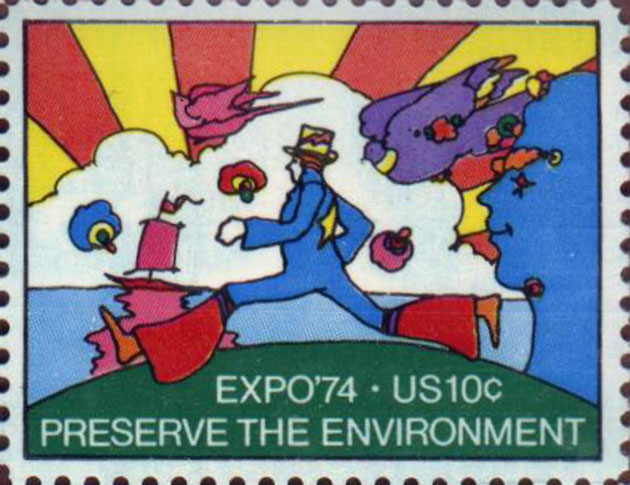 Image from Chapter 28 of U.S. History (opens in new window) from OpenStax, licensed under Creative Commons Attribution License v4.0 with the image information: Pop artist Peter Max designed this postage stamp to commemorate Expo ‘74, a world’s fair held in Spokane, Washington. The fair’s theme was the natural environment. Unfortunately, and ironically, gasoline shortages prevented many from attending the exposition.This module explores the United States from 1968-1980. In the late 1960s and 1970s, Native Americans, LGBTQ people, and women organized to change discriminatory laws and pursue government support for their interests, a strategy known as identity politics. During his Presidency, Nixon had little success with unemployment and inflation but did establish diplomatic relations with China. The war in Vietnam raged and the Watergate scandal brought down Nixon. The Carter Presidency had promise but economic woes and the hostage crisis in Tehran led to his loss in the 1980 election.Upon completion of this module, you will be able to:
Image from Chapter 28 of U.S. History (opens in new window) from OpenStax, licensed under Creative Commons Attribution License v4.0 with the image information: Pop artist Peter Max designed this postage stamp to commemorate Expo ‘74, a world’s fair held in Spokane, Washington. The fair’s theme was the natural environment. Unfortunately, and ironically, gasoline shortages prevented many from attending the exposition.This module explores the United States from 1968-1980. In the late 1960s and 1970s, Native Americans, LGBTQ people, and women organized to change discriminatory laws and pursue government support for their interests, a strategy known as identity politics. During his Presidency, Nixon had little success with unemployment and inflation but did establish diplomatic relations with China. The war in Vietnam raged and the Watergate scandal brought down Nixon. The Carter Presidency had promise but economic woes and the hostage crisis in Tehran led to his loss in the 1980 election.Upon completion of this module, you will be able to:- Describe the counterculture of the 1960s (CO 1-7)
- Explain the origins of the American Indian Movement and its major activities (CO 1-7)
- Assess the significance of the gay rights and women’s liberation movements (CO 1-5)
- Explain the factors responsible for Richard Nixon’s election in 1968 (CO 1-5)
- Describe the splintering of the Democratic Party in 1968 (CO 1-5)
- Discuss Richard Nixon’s economic policies (CO 1-5)
- Discuss the major successes of Richard Nixon’s foreign policy (CO 1-5)
- Describe the events that fueled antiwar sentiment in the Vietnam era (CO 1-7)
- Explain Nixon’s steps to withdraw the United States from the conflict in South Vietnam (CO 1-5)
- Describe the actions that Nixon and his confederates took to ensure his reelection in 1972 (CO 1-5)
- Explain the significance of the Watergate crisis (CO 1-5)
- Describe Gerald Ford’s domestic policies and achievements in foreign affairs (CO 1-5)
- Explain why Gerald Ford lost the election of 1976 (CO 1-5)
- Describe Jimmy Carter’s domestic and foreign policy achievements (CO 1-5)
- Discuss how the Iranian hostage crisis affected the Carter presidency (CO 1-5)
To achieve these objectives:- Read the Module 14 Introduction above.
- Read and view the materials in Module 14 (click below)
- View the Module 14 PowerPoint below.
- Complete Module 14 quizzes/assignments/discussion boards based on chapter/document reading.
Module Pressbooks Resources and Activities
You will find the following resources and activities in this module at the Pressbooks website. Click on the links below to access or complete each item.
-
 Image from Chapter 31 of U.S. History (opens in new window) from OpenStax, licensed under Creative Commons Attribution License v4.0 with the image information: This striking piece of graffiti from the Berlin Wall (modified), now housed in the Newseum in Washington, DC, contains the name of the AIDS Coalition to Unleash Power (ACT UP), a group formed in 1987 in New York City to combat the spread of AIDS and the perception that AIDS was the product of immoral behavior.This module explores the United States from 1980 to the present. After decades of liberalism and social reform, Ronald Reagan changed the face of American politics by riding a groundswell of conservatism into the White House. The political conservatism of the 1980s and 1990s was matched by the social conservatism of the period. Conservative politicians wished to limit the size and curb the power of the federal government. While Ronald Reagan worked to restrict the influence of the federal government in people’s lives, he simultaneously pursued interventionist policies abroad as part of a global Cold War strategy.
Image from Chapter 31 of U.S. History (opens in new window) from OpenStax, licensed under Creative Commons Attribution License v4.0 with the image information: This striking piece of graffiti from the Berlin Wall (modified), now housed in the Newseum in Washington, DC, contains the name of the AIDS Coalition to Unleash Power (ACT UP), a group formed in 1987 in New York City to combat the spread of AIDS and the perception that AIDS was the product of immoral behavior.This module explores the United States from 1980 to the present. After decades of liberalism and social reform, Ronald Reagan changed the face of American politics by riding a groundswell of conservatism into the White House. The political conservatism of the 1980s and 1990s was matched by the social conservatism of the period. Conservative politicians wished to limit the size and curb the power of the federal government. While Ronald Reagan worked to restrict the influence of the federal government in people’s lives, he simultaneously pursued interventionist policies abroad as part of a global Cold War strategy.
Bill Clinton’s presidency and efforts at remaking the Democratic Party reflect the long-term effects of the Reagan Revolution that preceded him. George W. Bush’s first term in office began with al-Qaeda’s deadly attacks on the World Trade Center and the Pentagon on September 11, 2001 and, when he took office, he cut tax rates for the rich and tried to limit the role of government in people’s lives. The nation’s increasing diversity—and with it, the fact that White Caucasians will soon be a demographic minority—prompted a conservative backlash that continues to manifest itself in debates about immigration.
Despite Republican resistance and political gridlock in Washington during his first term in office, President Barack Obama oversaw the distribution of the TARP program’s $7.77 trillion to help shore up the nation’s banking system, and Congress authorized $80 billion to help Chrysler and General Motors. The goals of Obama’s Patient Protection and Affordable Care Act (Obamacare) were to provide all Americans with access to affordable health insurance, to require that everyone in the United States had some form of health insurance, and to lower the costs of healthcare. During his second term, the nation struggled to grow modestly, the percentage of the population living in poverty remained around 15 percent, and unemployment was still high in some areas. Acceptance of same-sex marriage grew, and the United States sharply reduced its military commitments in Iraq and Afghanistan.
Upon completion of this module, you will be able to:From Cold War to Culture Wars, 1980-2000
- Explain Ronald Reagan’s attitude towards government (CO 1-5)
- Discuss the Reagan administration’s economic policies and their effects on the nation (CO 1-5)
- Discuss the culture wars and political conflicts of the Reagan era (CO 1-7)
- Describe the Religious Right’s response to the issues of the Reagan era (CO 1-5)
- Describe the successes and failures of Ronald Reagan’s foreign policy (CO 1-5)
- Compare the policies of Ronald Reagan with those of George H. W. Bush (CO 1-5)
- Explain the causes and results of the Persian Gulf War (CO 1-5)
- Discuss the events that constituted the end of the Cold War (CO 1-5)
- Explain political partisanship, anti-government movements, and economic developments during the Clinton administration (CO 1-7)
- Discuss President Clinton’s foreign policy (CO 1-5)
- Explain how George W. Bush won the election of 2000 (CO 1-5)
The Challenges of the Twenty-First Century
- Discuss how the United States responded to the terrorist attacks of September 11, 2001 (CO 1-5)
- Explain why the United States went to war against Afghanistan and Iraq (CO 1-7)
- Describe the treatment of suspected terrorists by U.S. law enforcement agencies and the U.S. military (CO 1-5)
- Discuss the Bush administration’s economic theories and tax policies, and their effects on the American economy (CO 1-5)
- Explain how the federal government attempted to improve the American public education system (CO 1-5)
- Describe the federal government’s response to Hurricane Katrina (CO 1-5)
- Identify the causes of the Great Recession of 2008 and its effect on the average citizen (CO 1-5)
- Describe the efforts to reduce the influence of immigrants on American culture (CO 1-7)
- Describe the evolution of twenty-first-century American attitudes towards same-sex marriage (CO 1-3)
- Explain the clash over climate change (CO 1-5)
- Describe how Barack Obama’s domestic policies differed from those of George W. Bush (CO 1-5)
- Discuss the important events of the war on terror during Obama’s two administrations (CO 1-5)
- Discuss some of the specific challenges facing the United States as Obama’s second term draws to a close (CO 1-7)
To achieve these objectives:
- Read the Module 15 Introduction above.
- Read and view the materials in Module 15 (click below)
- View the Module 15 PowerPoints below.
- Complete Module 15 quizzes/assignments/discussion boards based on chapter/document reading.
Module Pressbooks Resources and Activities
You will find the following resources and activities in this module at the Pressbooks website. Click on the links below to access or complete each item.
-

In this module you will take your final exam. Read the instructions carefully and take note of any special submission guidelines.
TO REVIEW TEAM: A Final Exam has not been uploaded at this point. One will be created over the summer if deemed necessary by the review team.
Upon completion of this module, you will have:
- Read and viewed the final exam instructions
- Scheduled your exam with the proctoring service (If necessary)
- Prepared for and submitted your final exam
To achieve these objectives:
- Read and view the contents of "Exam Information and Instructions"
- Log in to the proctoring service (if necessary) and take your exam.
